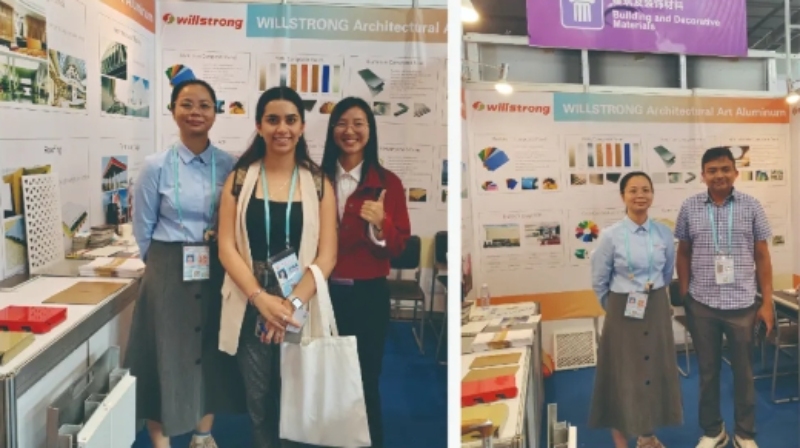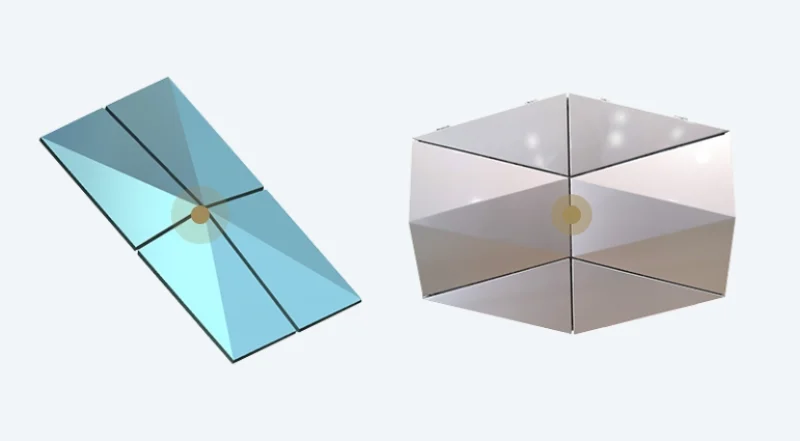Steel Composite Panel Solution: Unveiling Performance, Aesthetics & More
In the realm of construction and architecture, the steel composite panel solution stands out as a game-changer. This innovative approach combines strength, durability, and aesthetic appeal in one versatile package. With its roots tracing back to the mid-20th century, this solution has evolved to meet modern design and functionality requirements seamlessly. Architects and builders now turn to steel composite panels for their projects due to their lightweight nature, ease of installation, and ability to withstand various environmental conditions. As we delve deeper into the world of steel composite panels, let's explore how this solution continues to shape the landscape of contemporary construction practices.
Unveiling Steel Composite Panels
Concept & Composition
Steel composite panels are innovative composite panel systems that combine various materials like steel, aluminum, and other metals to create a sturdy, versatile building material. These panels typically consist of a core layer sandwiched between two outer layers of metal, providing exceptional strength and durability.
Steel composite panels are known for their lightweight nature despite being incredibly strong, making them ideal for various construction projects. The composition of these panels allows for customization in terms of color, finish, and texture, catering to different architectural styles and design preferences.
Key Features & Advantages
The key features of steel composite panels include their resistance to corrosion, impact, and fire. Due to the use of high-quality materials like stainless steel in their composition, these panels offer longevity and low maintenance requirements. The installation process is streamlined thanks to innovative techniques such as the use of a patented sliding clip system.
One significant advantage of steel composite panels is their energy efficiency. The insulating properties of these panels help regulate indoor temperatures, reducing heating and cooling costs for buildings where they are installed. Moreover, their sleek appearance adds a modern touch to structures while offering structural integrity.
Applications & Industries
Steel composite panels find wide applications across various industries such as architecture, construction, automotive manufacturing, and interior design. In the architectural sector, these panels are commonly used for exterior cladding due to their weather resistance and aesthetic appeal.
In the construction industry, steel composite panels serve as an excellent choice for roofing systems and wall partitions due to their durability and ease of installation. Automotive manufacturers utilize these panels in vehicle interiors for both functional purposes like sound insulation as well as enhancing visual appeal.
Performance Testing Excellence
Rigorous Testing Procedures
Steel composite panels are tested rigorously to ensure their durability and performance in various conditions. These panels undergo a series of tests, including impact resistance, weatherability, and fire resistance tests. The testing procedures guarantee that the panels meet industry standards for quality and safety.
Performance Standards and Certifications
Steel composite panels are known for their exceptional performance standards, backed by certifications such as ISO 9001 and ASTM International. These certifications validate the quality of the panels and assure customers of their reliability. Steel composite panels often exceed regulatory requirements for construction materials.
Comparison with Traditional Materials
When comparing the finishes of steel composite panels with traditional building materials like concrete or wood, the advantages become evident. Steel composite panels offer superior finishes that are resistant to fading, chalking, and staining. Moreover, they require minimal maintenance compared to traditional materials.
Aesthetic Appeal and Varieties
Customization Options
Steel composite panels offer a wide variety of aesthetic options, making them a versatile choice for architectural projects. These panels come in numerous designs, colors, textures, and patterns, allowing for endless customization possibilities. With a broad spectrum of choices available, architects and designers can create unique looks tailored to specific project requirements.
The customization options for steel composite panels extend beyond just colors. Architects can choose from different finishes such as matte or glossy surfaces to achieve the desired visual effect. The ability to combine various colors and textures on different sections of a building facade adds depth and dimension to the overall design.
Visual Enhancement in Architecture
Steel composite panels play a crucial role. The sleek and modern look of these panels can transform the exterior of buildings, giving them a contemporary appearance. Whether used for commercial structures or residential buildings, steel composite panels offer a seamless finish that elevates the overall aesthetics.
Architects can experiment with different panel shapes and configurations to create visually striking facades that stand out. By incorporating steel composite panels into their designs, architects have the flexibility to play with light and shadow effects, adding an element of dynamism to the building's exterior. This versatility allows for innovative architectural expressions that capture attention and leave a lasting impression on viewers.
Advantages:
- Versatile customization options
- Enhanced visual appeal in architecture
Simplified Installation Process
Time-Saving Steps
Steel composite panels offer a streamlined installation process that significantly reduces construction time. The panels are lightweight, making handling and placement quick and efficient. With simple interlocking mechanisms, the wall system can be assembled rapidly.
The installation of steel composite panels involves a few key steps. Firstly, the underlying structure is prepared to support the panels securely. Next, the panels are lifted into place and attached using fasteners or adhesives. Finally, any necessary finishing touches are applied to ensure a seamless appearance.
Cost-Efficiency Benefits
One of the primary advantages of utilizing steel composite panels in construction projects is their cost-effectiveness. Due to their simplified installation process, labor costs are reduced as less time is required for assembly. The durability of these panels minimizes maintenance expenses over time.
Steel composite panels also contribute to energy efficiency by providing excellent insulation properties. This feature helps regulate indoor temperatures, leading to lower heating and cooling costs for buildings constructed with these innovative systems.
Easy Maintenance and Repair
Maintaining steel composite panels is hassle-free due to their durable nature and resistance to wear and tear. Routine cleaning with mild soap and water keeps the panels looking pristine without requiring extensive upkeep efforts.
In case of damage or wear, individual panels can be easily replaced without disrupting the entire system. This targeted approach to repairs ensures that any issues can be swiftly addressed without incurring significant costs or causing delays in building maintenance.
Durability and Longevity Benefits
Weather Resistance
Steel composite panels offer exceptional durability due to their high resistance to various weather conditions. From scorching heat to heavy rain, these panels maintain their structural integrity without warping or deteriorating.
Lifespan Expectancy
The longevity of steel composite panels is impressive, often surpassing traditional building materials. With proper maintenance, these panels can last for decades, providing a cost-effective solution for construction projects.
Steel composite panels are designed to withstand corrosion and fading over time, ensuring that the building maintains its aesthetic appeal for years to come.
Sustainable Construction Practices
In today's environmentally conscious world, using steel composite panels is a step towards sustainable construction practices. These panels are recyclable and contribute to reducing waste during both manufacturing and demolition processes.
Enhancing Features for Robustness
Structural Strength
Steel composite panels are renowned for their exceptional structural strength due to the combination of materials. The steel core provides a sturdy foundation, enhancing the overall durability of the panel. This robust construction ensures that the panels can withstand high impact forces without compromising their integrity.
Impact Resistance
One of the key advantages of steel composite panels is their impressive impact resistance. The steel core, along with advanced cladding materials, creates a protective barrier that shields buildings from external damage. In areas prone to harsh weather conditions or potential impacts, such as industrial zones or busy urban settings, these panels offer reliable protection against wear and tear.
Fire-Retardant Properties
Safety is paramount in any building design, making the fire-retardant properties of steel composite panels invaluable. These panels are engineered to inhibit the spread of flames in case of a fire outbreak, providing crucial time for evacuation and minimizing property damage. By incorporating steel cores and specially formulated cladding materials, these panels offer an added layer of security against fire hazards.
Lightweight Yet Sturdy
Despite their robust construction and superior strength, steel composite panels are remarkably lightweight. This unique combination of lightweight design and structural integrity makes them an ideal choice for various architectural applications. Whether used in high-rise structures or commercial buildings, these panels offer a balance between ease of installation and long-lasting performance.
Impact and Pollution Resistance
Corrosion Resistance
Steel composite panels, with their polyethylene core sandwiched between layers of aluminum, exhibit exceptional resistance to corrosion. This feature ensures longevity and durability in various environments.
The polyethylene core acts as a protective barrier against moisture, preventing water ingress that could lead to rust or corrosion. This design makes steel composite panels ideal for rainscreen applications where exposure to water is common.
Anti-Pollution Properties
Steel composite panels are designed to withstand pollution and environmental contaminants effectively. The aluminum surfaces provide a smooth finish that resists dirt buildup, making maintenance hassle-free.
With the ability to resist staining from pollutants like dust, smog, and other airborne particles, steel composite panels retain their aesthetic appeal over time. This low-maintenance aspect is highly beneficial for commercial buildings and high-traffic areas.
Energy Efficiency and Sustainability
In addition to their robustness, steel composite panels contribute significantly to energy efficiency and green building standards. The insulating properties of the polyethylene core help regulate indoor temperatures, reducing reliance on heating or cooling systems.
Insulation and Noise Reduction Capabilities
Thermal Insulation
Steel composite panels offer exceptional thermal insulation, helping maintain consistent indoor temperatures. The panels act as a barrier, reducing heat transfer through walls and roofs.
They consist of an insulating core sandwiched between two layers of steel, providing effective insulation against extreme temperatures. This feature significantly reduces the need for excessive heating or cooling systems.
Soundproofing Benefits
The soundproofing capabilities of steel composite panels make them ideal for noise-sensitive environments. The dense structure and insulating core absorb sound waves, minimizing external noise intrusion.
By installing these panels, buildings can achieve optimal acoustic performance, creating quiet and peaceful interiors. This is crucial in settings like offices, hospitals, or residential areas where noise control is essential.
Energy Efficiency
Incorporating steel composite panels in building designs offers significant energy-saving advantages. The superior thermal properties reduce reliance on heating and cooling systems, leading to lower energy consumption.
These panels contribute to sustainable construction practices by enhancing energy efficiency and reducing carbon footprints. By choosing steel composite solutions, builders can create environmentally friendly structures that prioritize energy conservation.
Processing Advantages and Peel Strength
Manufacturing Process
Steel composite panels are manufactured by bonding two metal sheets to a polyethylene core. This process involves advanced technology like roll bonding for optimal adhesion between layers.
The steel sheets undergo surface treatment to enhance corrosion resistance, ensuring durability in various environments. These panels are then cut into desired sizes for construction applications.
Technological Advancements
Recent advancements have introduced innovative methods like continuous coil coating to improve panel quality. This technique ensures uniform coating thickness, enhancing aesthetics and longevity.
Moreover, the introduction of digital printing technology allows for customizable designs on steel composite panels, catering to diverse architectural preferences.
Peel Strength and Bonding Mechanisms
Peel strength refers to the force required to separate the layers of a composite panel. Steel composite panels exhibit high peel strength due to their robust bonding mechanisms.
The strong bond between the metal sheets and the core material results in exceptional peel strength, making these panels resistant to delamination even under extreme weather conditions.
Cost-Effectiveness and Efficiency
Utilizing steel composite panels in construction projects offers significant cost savings due to their lightweight nature, reducing transportation costs and installation time.
These panels require minimal maintenance, contributing to long-term cost-effectiveness while providing excellent thermal insulation properties for energy efficiency in buildings.
Closing Thoughts
In your quest for the ideal steel composite panel solution, you've delved into a world of innovation, durability, and aesthetic appeal. From performance testing excellence to simplified installations, these panels offer a myriad of benefits that cater to your needs. Their robustness, impact resistance, and insulation capabilities make them a versatile choice for various applications.
As you consider the advantages of steel composite panels showcased in this article, remember the transformative power they hold in enhancing structures. Whether for commercial or residential projects, these panels provide a winning combination of strength and style. Embrace the future of construction with steel composite panels and elevate your projects to new heights.
Frequently Asked Questions
What are Steel Composite Panels?
Steel composite panels are innovative building materials that combine steel sheets with a core material, providing strength, durability, and versatility for various architectural applications.
How do Steel Composite Panels enhance building aesthetics?
Steel composite panels offer a wide range of color options and finishes, allowing architects and designers to create visually appealing facades that complement different architectural styles.
Are Steel Composite Panels easy to install?
Yes, steel composite panels feature a simplified installation process due to their lightweight nature and interlocking design, making them quick and efficient to install compared to traditional building materials.
What benefits do Steel Composite Panels offer in terms of durability?
Steel composite panels provide excellent durability and longevity benefits by being resistant to corrosion, weathering, impact damage, and fading over time, ensuring long-lasting performance.
Do Steel Composite Panels offer insulation properties?
Yes, steel composite panels have inherent insulation properties that help regulate indoor temperatures by reducing heat transfer through walls while also offering noise reduction capabilities for enhanced comfort.
Let's Connect.
 Leave a Message
Leave a Message

 Chinese
Chinese Thailand
Thailand Vietnam
Vietnam Indonesia
Indonesia India
India



